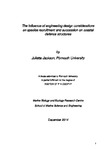The influence of engineering design considerations on species recruitment and succession on coastal defence structures
| dc.contributor.supervisor | Thompson, Richard | |
| dc.contributor.author | Jackson, Juliette Elizabeth | |
| dc.contributor.other | Faculty of Science and Engineering | en_US |
| dc.date.accessioned | 2016-06-01T14:12:36Z | |
| dc.date.available | 2016-06-01T14:12:36Z | |
| dc.date.issued | 2015 | |
| dc.date.issued | 2015 | |
| dc.identifier | 704999 | en_US |
| dc.identifier.uri | http://hdl.handle.net/10026.1/4781 | |
| dc.description.abstract |
Engineering design considerations of artificial coastal structures were tested to resemble as far as possible the nearest natural equivalent habitat, ecologically valuable rocky shores, as a potential management option. Coastal areas around the world attract urbanisation but these transitional areas between sea and land are inherently vulnerable to risk of flooding and erosion. Thus hard structures are often built in sensitive coastal environments to defend assets such as property and infrastructure (roads, railways, ports) against rising and stormy seas. The design, construction and maintenance of hard defences should wherever possible incorporate ecological considerations to enhance biodiversity, including maintaining or restoring natural habitats and wild species to ensure favourable conservation status. Artificial habitats are less topographically complex than natural rocky shores, at millimetre scales in terms of surface roughness, centimetre to meter scales for crevices and pools to tens, hundreds and occasionally thousands of meters for variation in tidal height and wave action gradients. The habitat value of design features of an existing seawall and breakwater, such as areas of different slope and orientation, and the presence of crevices and pools, that are analogous to habitat created by topographical features on a natural shore, were demonstrated by their ability to support distinct assemblages of species. X Furthermore, evidence is provided that a greater variation in the type of design features led to a higher species diversity occupying the structure, and included species that would otherwise not be present on the structure. The long term succession on artificial structures and the biodiversity reached on intertidal coastal defence structures is described to inform understanding of timescales over which successional processes operate. As a consequence of succession, artificial structures of large extent eventually resemble natural rocky shores of the same exposure. Increased surface heterogeneity of concrete armour units on Plymouth Breakwater by drilling holes was effective in adding habitat and increasing local species diversity. These can be added at the construction stage or post construction. In a real case study, added recessed pools, holes and surface texture during the construction of a tidal defence sea wall at Shaldon made heterogeneous surfaces to add habitat and influence species diversity, without compromising the engineering function or aesthetics of the structure. This study provides coastal engineers and decision makers with well researched practical design options to inform future construction and maintenance of coastal defence structures that will encourage specific outcomes to mitigate the negative environmental impact of artificial structures and contribute to conservation priorities. | en_US |
| dc.language.iso | en | en_US |
| dc.publisher | Plymouth University | en_US |
| dc.subject | Coastal defences | |
| dc.subject | Species recruitment | |
| dc.subject | Species sucession | |
| dc.subject | Engineering design | en_US |
| dc.title | The influence of engineering design considerations on species recruitment and succession on coastal defence structures | en_US |
| dc.type | Thesis | |
| plymouth.version | Full version | en_US |
| dc.identifier.doi | http://dx.doi.org/10.24382/3335 |
Files in this item
This item appears in the following Collection(s)
-
01 Research Theses Main Collection
Research Theses Main


